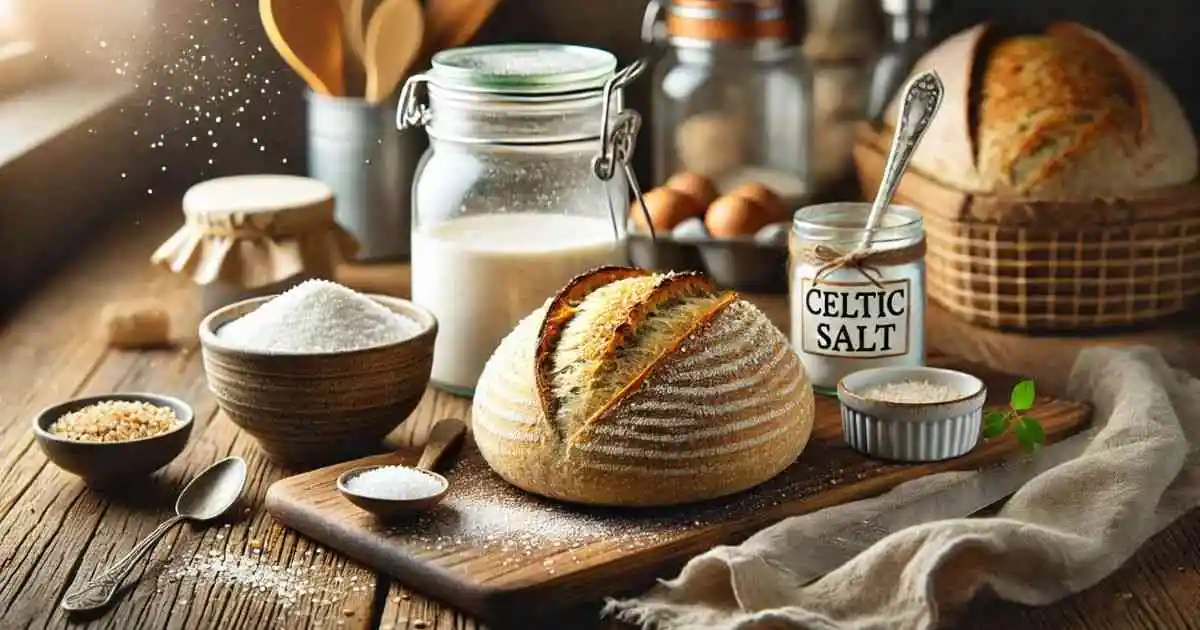
Introduction
Sourdough bread has great taste because of this quality it is a favorite in many homes and it is good for health. In Sourdough bread recipes, people try different things and they often wonder what ingredients can make the bread taste even better. One ingredient that comes up is Celtic salt, a sea salt that comes with a lot of minerals and a unique flavor. But could I add Celtic salt to my sourdough bread recipe? In this article well look at the pros and cons of adding Celtic salt to your sourdough. You may also read “Savory Crab Brulee Recipe“.
Understanding Celtic Salt
What is Celtic Salt?
Celtic salt known as gray salt is a type of sea salt gathered from the coastal region of France. Unlike regular table salt, which is highly processed, Celtic salt is rough and keeps its natural minerals that give an amazing grayish shade. This salt is harvested by hand using classic methods that have been passed through eras and make sure its purity and grade.
Nutritional Benefits of Celtic Salt
Celtic salt is well known for its mineral content, the list of minerals that includes magnesium, potassium, calcium, and trace elements that are good for human health. The Celtic salt is chosen by people who are nervous about their health since these minerals add to its total health advantages and enhance food taste.
Celtic Salt vs. Other Types of Salt
The differences are notable when comparing Celtic salt and other types of salt, like table salt or Himalayan pink salt. While table salt is mostly formed of sodium chloride and often includes additives, Celtic salt remains in its natural form which delivers a more complicated flavor profile. Himalayan pink salt is also another popular choice that shares some similarities with Celtic salt but it is different in its mineral composition and origin.
Comparison of Celtic Salt vs. Regular Table Salt in Sourdough Bread
| Aspect | Celtic Salt | Regular Table Salt |
| Processing | Unrefined, retains natural minerals | Highly processed, often contains additives |
| Flavor Profile | Earthy, complex, slightly briny | Sharp, straightforward, can be overpowering |
| Texture | Coarse, retains moisture | Fine, dry |
| Nutritional Content | Rich in minerals like magnesium, potassium, calcium | Primarily sodium chloride lacks additional minerals |
| Impact on Dough | Can affect dough hydration due to moisture content | Consistent, no effect on dough hydration |
| Health Considerations | Provides essential minerals, less processed | High in sodium, lacks additional health benefits |
| Use in Sourdough | Enhances flavor with a unique taste, requires adjustment in hydration | Provides necessary saltiness, no special adjustments needed |
| Rising Time | May slightly alter fermentation due to mineral content | No significant impact on fermentation |
| Versatility in Baking | Adds unique flavor to a variety of baked goods | Commonly used, suitable for most baking needs |
| Storage | Requires airtight storage to prevent clumping | Easy to store, less prone to clumping |
Salt’s Function in Sourdough Bread
The Significance of Salt in Sourdough Bread
Salt plays a vital role in sourdough focaccia bread, not only for flavor but also for its results on the dough structure and fermentation procedure. It helps to support the gluten network and gives the bread its chewy texture and it also controls the activity of yeast and bacteria during the process of fermentation.
How Salt Affects the Fermentation Process?
In the process of fermentation, the wild yeast and lactic acid bacteria complete the making process of sourdough bread. Salt slows down this fermentation, allowing the dough to develop more complex flavors over time. This is important in sourdough baking, Where the balance between yeast and bacteria is key to gaining the selected taste and texture.
The Impact of Salt on Flavor and Texture
Sourdough bread can taste flat without salt. Salt can improve the natural flavor of the flour and many other ingredients and it also contributes to the color of the crust. The texture of the bread is also affected by salt, as it helps to control the moisture range in the dough, resulting in a well-structured crumb.
Could I Add Celtic Salt to My Sourdough Bread Recipe?

How to Use Celtic Salt in Sourdough?
When adding Celtic salt to your sourdough recipe, it is necessary to evaluate its rough texture. Dissolving the salt in the water before mixing it into the dough can help ensure even distribution. You might also want to experiment with the amount of salt to find the perfect balance for your taste.
Potential Challenges with Celtic Salt
One challenge of using Celtic salt is its moisture content which can just change the hydration of dough. This means you might need to change the water in your recipe to reach the right dough, You can find a way that works well for you.
Flavor Profile of Celtic Salt in Sourdough
How Celtic Salt Influences the Taste of Sourdough?
Celtic salt adds a subtle, earthly flavor to sourdough bread that makes it better and tasty. The minerals in the salt donate to a more complicated flavor profile and give the bread a depth that is often missing with regular table salt.
Comparing the Flavor of Celtic Salt to Other Salts
Compared to table salt, which can be sharp and overpowering, Celtic salt offers a milder, more taste. When compared to Himalaya pink salt, Celtic salt has a slight flavor, which pairs well with the spicy notes of sourdough.
Enhancing Your Sourdough Recipe with Celtic Salt
If you are looking to enhance your sourdough foccacia bread, Celtic salt can be a great addition. Its great flavor and mineral content make the bread taste better. They also add to the bread’s health benefits. Try to experiment with different amounts to find the perfect balance for your recipe.
Health Considerations

Health Benefits of Celtic Salt in Baking
The essential minerals that are often removed from ordinary table salt are abundant in Celtic salt. These minerals may support improved hydration and general health. Baking with Celtic salt permits you to achieve these advantages in your diet naturally.
Sodium Content and Its Impact on Health
While Celtic salt is slightly processed and includes more minerals, it is still important to monitor your sodium input. Too much sodium is linked with medical problems like high blood pressure. Nonetheless, Celtic Salts have more nutrients than refined salts when some are used in moderation.
Celtic Salt — For Everyone, All The Time?
Most people enjoy a Celtic salt diet Nonetheless, Those with some medical conditions like kidney disease or people who have to feed on a low-sodium diet. If you have one of these diseases, talk to your healthcare provider before making changes in how much salt you get.
Tips for Baking with Celtic Salt
Measuring Celtic Salt for Consistent Results
Because Celtic salt is thicker than table salt and it is necessary to it accurately. A kitchen scale can help to ensure surface mainly when testing with different amounts.
Balancing Salt with Other Ingredients
When using Celtic salt it is important to remember the other ingredients in recipes should be stopped. The taste of salt can be more noticeable so consider how it will interact with the flour, water, and other ingredients.
Storing Celtic Salt for Optimal Freshness
If you want to store the Celtic salt fresh then store it in an airtight container in a cool place. This will help maintain its texture and flavor for next time.
Conclusion

To elevate the flavor and nutritional value of your bread then add Celtic salt to your sourdough bread recipe. Its unique mineral content and salty taste make it a wonderful alternative to regular salt and it offers a more delicious and easy baking experience. Whether you are a seasoned sourdough baker or just starting with Celtic salt can lead to delicious results.
FAQ’s
What type of salt is best for sourdough bread?
The sea salt is a high-quality salt for sourdough bread and it has many minerals like Celtic salt and pink Himalayan salt. These salts add flavor without harshness and contain many types of minerals.
Can you use Celtic salt in baking?
Yes, you can use Celtic salt in baking. It is especially good in recipes where you want a more complex flavor due to its mineral content.
How to add salt into sourdough?
Salt is basically added to the sourdough in the mixing stage. After the mixing of flour and water, the salt is sprinkled over the dough and mixed to ensure even distribution.
Does salt make sourdough more sour?
No, salt does not make sourdough more sour. It helps to balance the flavor and control the fermentation process which can prevent the bread from becoming sour.
Can you ferment with Celtic sea salt?
Yes, you can use Celtic salt for fermentation. its minerals can make the good flavor of fermented foods and take a part in the healthy fermentation process.
How much salt is too much for sourdough bread?
Basically, 2% of the total flavor weight is the amount of salt in sourdough bread. Going above this may result in making it more salty flavor.
What is best for baking sourdough?
The best ingredients for baking sourdough include good quality flour, water, and natural salts like Celtic and Himalayan are well known. Using organic ingredients can also enhance the flavor of your bread.
Can I use pink Himalayan salt in sourdough bread?
Yes, pink Himalayan salt can be used in the process of baking sourdough bread, It has a mild flavor that contains minerals to Celtic salt.
What is another name for Celtic salt
Celtic salt is also known as Gray salt and it gets its name from the traditional Celtic methods used to harvest it.

